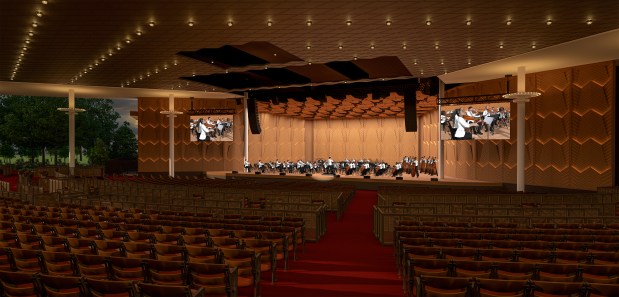The Ravinia Festival will renovate its grounds from now through 2029, starting with its 3,350-seat Pavilion, the festival announced Thursday.
Ravinia plans to unveil the updated Pavilion in July 2026 as the Hunter Pavilion, named for a $10 million donation by the Hunter Family Foundation.
The backstage area will also be renamed the Negaunee Foundation Artist Center, after a $21 million donation by the Negaunee Foundation. Lohan Architecture, a successor firm to Mies van der Rohe’s office, will lead the project, with additional acoustic consulting by Threshold Acoustics and stage design consulting by Schuler Shook.
The first phase of the Pavilion renovation, addressing backstage infrastructure such as artist facilities and loading areas, is already underway, according to comments and photographs provided by Ravinia President and CEO Jeff Haydon. The second phase will transform the Pavilion itself, improving the onstage acoustic and updating its seating, which dates to the 1950s.
“While this first phase might not be that noticeable cosmetically, it’ll really impact the experience, at least for the performers,” says chief conductor Marin Alsop.
The Pavilion is the largest seating area on the grounds of the outdoor music venue in Highland Park and hosts Ravinia’s biggest concerts over its annual summer seasons. It was constructed in 1949 to replace the former Ravinia pavilion, which was destroyed by fire during the off-season. Once considered temporary, its backstage area was built out permanently by a renovation in 1970. The Pavilion’s last major renovation was in 1995, when the backstage area was expanded to add administrative offices.
“During Jeff’s interview, in June of 2020, we walked into the pavilion, and I saw the look on his face — he crunched up his nose a little bit,” recalls Ravinia board chair Christopher Klein, chuckling. “I said, ‘This is going to be one of our top priorities if you become the CEO.’”
Improvements to the Pavilion are welcomed by musicians, too. Headliners range from the Chicago Symphony Orchestra, in its summer residency, to Sting, all with drastically different acoustic and backstage needs. Currently, the onstage acoustic is deafeningly loud for Chicago Symphony players and the backstage area is barely spacious enough to accommodate the orchestra, much less additional performers or pop stars with large production teams. The women’s dressing room facilities, a fraction of the size of the men’s facilities, are a relic of a time when the orchestra was predominantly male. (It is now approaching 40% women members.)
“For anything but an all-Mozart concert, I’m wearing earplugs onstage — and my section actually sits at the edge of the stage, with some distance between us and the brass,” says cellist Brant Taylor.
For example, one visual by Threshold Acoustics labeled decibel levels on the current Pavilion stage. In their mockup, much of the stage was bright red — dangerously loud. In response, Threshold invited Taylor and CSO piccolo player Jennifer Gunn to its downtown offices to discuss the current Pavilion shell design and experience various simulated acoustic settings.
Gunn and Taylor’s feedback inspired various changes to the acoustic shell, which will be manufactured by the Wenger Corporation in Minnesota. The new shell will be made of much lighter foam, coated with a reflective wood veneer — material that will allow the shell’s side walls to be adjusted more easily. That adjustment mechanism will be rebuilt, too, from a sliding track to a folding hinge system. Higher ceiling panels will allow orchestral sound more room to disperse, rather than clotting onstage.
“They’re hoping the changes — the raised ceiling, the different acoustic tiles on the side walls — will change the way we hear everything,” says Gunn.
Other updated elements include a larger, deeper stage and new flooring, replacing the springy, dancer-friendly wood implemented by George Balanchine during the 1970 renovation. The sides of the stage with LED screens will also become more flush with the stage, reducing distraction for musicians once in eyeshot of the monitors. The new stage and seating will incorporate design elements tying them closer aesthetically to the Prairie-style Martin Theatre, referenced in Ravinia’s logo.
Ravinia recently implemented some Pavilion improvements before this renovation project. In response to musician complaints about onstage temperature, the festival changed out incandescent bulbs to LEDs. Last year, the festival also installed a new sound system, which has already yielded positive feedback. Singer-songwriter James Taylor was so impressed he promptly booked a return engagement, scheduled for June 19.
“I ran into him right after the sound check, and he said, ‘Wow, this is a great sound system. Tell me more about it,’” Haydon recalls.
Lohan Architecture will also lead Ravinia’s successive renovations of its other venues through 2029, the festival’s 125th year. Bennett Gordon Hall will get a facelift, the Sandra K. Crown Theater will get a new stage, and the Martin Theatre, which dates to Ravinia’s opening in 1904, will see “structural restoration and enhanced production capabilities.” Meanwhile, a new outdoor performance stage will replace the Carousel Stage altogether.
Some $50 million of the $75 million price tag for the project has been raised to date.
The Hunter Family Foundation gift honors Maxine and Thomas B. Hunter III of Lake Forest, both involved donors of the festival.
“My mother was on the women’s board, and I have memories of going there with her and my grandmother to see the Chicago Symphony,” says Bill Hunter, their son. “It’s nice to be associated with Ravinia — it’s just the place to go to hear music in Chicago, as far as I’m concerned.”
Hannah Edgar is a freelance critic.
The Rubin Institute for Music Criticism helps fund our classical music coverage. The Chicago Tribune maintains editorial control over assignments and content.



